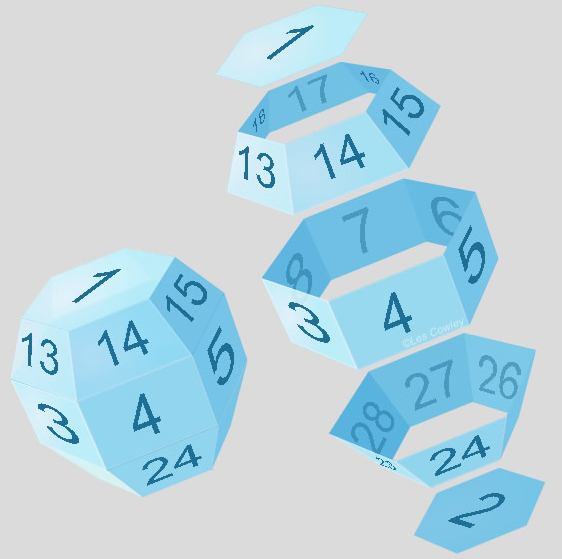Pyramidal Crystal Face Numbers
Pyramidal Crystal Face Numbers: Exploring the Intricacies of Atmospheric Optics
When it comes to atmospheric optics, pyramidal crystal face numbers offer a fascinating extension of the concepts applied to plates and columns. While the existing content briefly touched upon the topic, let's delve deeper into the intricacies of pyramidal crystal face numbers and their significance in creating stunning atmospheric phenomena.
Understanding the Face Numbering System
The face numbering system for pyramidal crystals provides a comprehensive way to identify and categorize the various faces present in these crystals. Here's a breakdown of the face numbers:
- Top and bottom hexagonal basal faces, if present, are assigned numbers 1 and 2 respectively.
- The middle prism faces are numbered from 3 to 8.
- The top pyramidal faces are represented by numbers 13 to 18.
- The lower pyramid faces are designated as 23 to 28.
This systematic approach allows researchers and enthusiasts to identify and analyze different crystal faces based on their specific numbering.
Unraveling the Odd Radius Halo
One fascinating phenomenon that can be observed using pyramidal crystal face numbers is the creation of an odd radius halo. This halo is formed by rays entering through the middle prism face numbered 3 and exiting through the lower pyramid face numbered 26. The specific angle between these faces, known as the wedge angle, measures 9°.
Interestingly, this angle differs from the more commonly observed 22° halo created by paths 3-5, which has a wedge angle of 60°. The uniqueness of the odd radius halo lies in its distinct formation, resulting from specific combinations of crystal face numbers.
Equivalent Path Descriptions
While path descriptions involving rays passing through faces 3 and 26 are commonly used to explain the odd radius halo, there are other equivalent paths that can be simplified to their lowest face number. Here are a few examples:
- Path 4-27
- Path 5-28
- Path 7-24
These paths create the same optical effect as the 3-26 path, but they are described using the lowest face number possible for simplicity and clarity. It's worth noting that the choice of path description does not affect the resulting atmospheric phenomenon but rather serves as a means of communication and understanding.
The Complexity of Atmospheric Optics
The study of pyramidal crystal face numbers highlights the complexity and diversity of atmospheric optics. The intricate interplay between crystal faces and the resulting optical effects is a captivating subject for researchers and enthusiasts alike. By understanding the numerical patterns and relationships between crystal faces, we can gain deeper insights into the mesmerizing phenomena occurring in our atmosphere.
Further Exploration and Research
While this article provides a comprehensive overview of pyramidal crystal face numbers, there is still much to explore and discover in the field of atmospheric optics. Researchers continue to investigate the unique properties of different crystal structures and their impact on atmospheric phenomena. By delving deeper into these intricate details, we can enhance our understanding of the natural wonders that unfold above us.
Conclusion
In conclusion, pyramidal crystal face numbers play a crucial role in unraveling the mysteries of atmospheric optics. By assigning specific numbers to different crystal faces, scientists and enthusiasts can analyze and interpret the optical effects created by these crystals. The odd radius halo, with its unique formation involving faces 3 and 26, stands as a captivating example of the interplay between crystal faces and atmospheric phenomena. As we continue to explore this field, our understanding of the complexities of atmospheric optics grows, revealing the awe-inspiring beauty hidden within our skies.

Pyramidal crystal face numbers are an extension of those for plates and columns.
Top and bottom hexagonal basal faces, if they exist, are numbered 1 and 2.
The middle prism faces are 3 to 8.
The top pyramidal faces are 13 to 18 and the lower pyramid faces are 23 to 28
A 9° odd radius halo is made by 3-26 rays i.e. rays entering the middle prism face 3 and leaving through lower pyramid face 26.
The wedge angle is 28° compared with the 60° paths 3-5 giving the more common 22° halo.
4-27 or 5-28 or 7-24 rays are equivalent to 3-26 but the path description is always simplified to the lowest face number where possible.
Note: this article has been automatically converted from the old site and may not appear as intended. You can find the original article here.
Reference Atmospheric Optics
If you use any of the definitions, information, or data presented on Atmospheric Optics, please copy the link or reference below to properly credit us as the reference source. Thank you!
-
<a href="https://atoptics.co.uk/blog/pyramidal-crystal-face-numbers/">Pyramidal Crystal Face Numbers</a>
-
"Pyramidal Crystal Face Numbers". Atmospheric Optics. Accessed on November 26, 2024. https://atoptics.co.uk/blog/pyramidal-crystal-face-numbers/.
-
"Pyramidal Crystal Face Numbers". Atmospheric Optics, https://atoptics.co.uk/blog/pyramidal-crystal-face-numbers/. Accessed 26 November, 2024
-
Pyramidal Crystal Face Numbers. Atmospheric Optics. Retrieved from https://atoptics.co.uk/blog/pyramidal-crystal-face-numbers/.